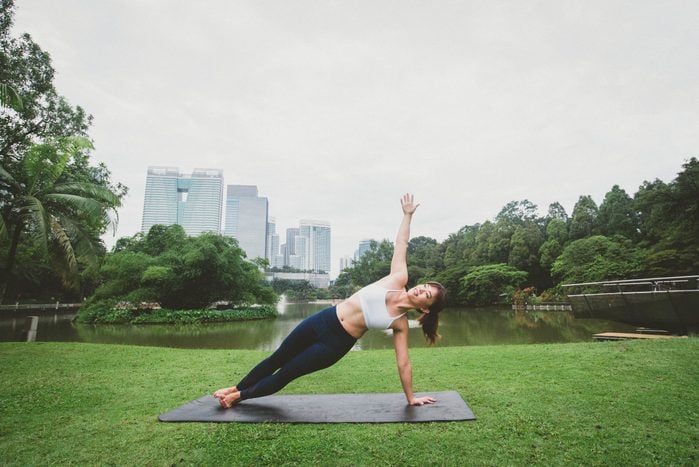Here Are Stretches and Yoga Moves That Can Help Scoliosis

If you have scoliosis, stretching, yoga, and specific exercises may help you reduce pain and strengthen your body.
Scoliosis, a condition that involves a curvature of the spine, affects about 3 percent of people. The abnormal spinal curvature that defines scoliosis often occurs laterally (or to one side), in an S- or C-shape, according to Medtronic Canada.
Depending on the degree of curvature, some people’s daily lives may not be dramatically affected, while others may have aches, pain, or other problems. That’s why it’s helpful to know about scoliosis stretches and yoga moves that might help scoliosis.
(Related: Do Posture Correctors Work?)
How scoliosis is diagnosed
While anyone can get scoliosis, and experts aren’t positive what causes the issue, it usually occurs in children 11 years old or older and happens in girls more often than boys. Many people find out they have scoliosis in school when getting their spine alignment checked by a school nurse or doctor, says Loren Fishman, MD, director of Manhattan Physical Medicine and Rehabilitation. Other times, someone might experience pain, often in the lower ribs or the back, typically (but not always) on the side that’s bulging.
A patient might also notice that their clothes don’t fit quite right, Dr. Fishman says. Those who are older may also experience degenerative scoliosis, which might come with side effects like breathing issues or strains in heart function, Dr. Fishman adds. An X-ray will confirm a scoliosis diagnosis.
While scoliosis doesn’t typically limit someone’s ability to live a normal life, it can affect a patient’s range of motion in all directions, says physical therapist Peter Bowman, assistant professor in the department of physical therapy and rehabilitation science at the University of Maryland School of Medicine. These limitations can show up due to a prominent shoulder blade, a rib hump, or shoulder and or pelvic asymmetries, causing one hip to be higher than the other.
“This may lead to discomfort or difficulty with movement that requires twisting and turning, reaching, and cardiovascular endurance,” Bowman says. “Commonly, this causes difficulty walking, lifting, carrying objects, or participating in sports.”
(Related: Muscle Imbalance: Signs and How to Fix It)
How do you treat scoliosis?
Sometimes scoliosis just requires monitoring the curve in the spine, so it doesn’t get worse. For other patients, it might require a brace, physical therapy, or in some cases, surgery.
(Related: 6 Helpful Products for Lower Back Pain)
The benefits of exercise, yoga, and stretching for scoliosis
Bowman says strengthening the core and ensuring proper spine positioning can help those with scoliosis experience less pain and limitations. “Generally, it is recommended to remain active and identify activities that do not aggravate an individual’s symptoms,” he says.
A physical therapist can help determine stretches and exercises that work best for each individual and how and when to do them. “Physical therapy may also help to increase balance, spine mobility, and cardiovascular conditioning,” he adds. “Strengthening and stretching for the mid- and lower-back, hips and shoulders may help with an individual’s symptoms as well.”
To explain the benefits of these yoga stretches for scoliosis and strengthening the body to counteract the curve, Dr. Fishman says to think of the body as a tent pole, with many lines pulling down on all sides to keep the pole upright. “We’re vertical because muscles pull us symmetrically,” he says. “But if the muscles on one side are stronger or the lines tighter, then the pole would curve to one side.”
If they pull to the right, then the ribs on the left would splay out. “So if you look at scoliosis as strength on one side, then we want to strengthen the convex side,” or the outer angle, he explains.
Ingrid Yang, MD, a yoga instructor and physician, says since postural muscles are integral in causing scoliosis, strength, and endurance are the main goals in non-surgical treatment of scoliosis.
(Related: Simple Desk Stretches to Improve Posture)
Scoliosis stretches and yoga moves to consider
Dr. Fishman often incorporates yoga exercises into his work with patients and has studied the practice’s effects on the spine’s curve. According to one of his studies published in Global Advances in Health and Medicine, the side plank pose, in particular (done on the side opposite the bulge), works to lower the degree of the curve.
Another one of Dr. Fishman’s studies, also published in Global Advances in Health and Medicine, supports the idea of practicing side plank, along with half-moon pose.
Dr. Yang also mentions isometric yoga postures may help reduce the asymmetrical curvature that causes scoliosis and aches associated with the condition.
Dr. Fishman does suggest working with a professional to make sure you’re performing the moves correctly and in a way that will help the curvature, even if you’re familiar with these exercises.
(Related: How to Relieve Stress, Bloating, and Fatigue With Yoga)
Exercises to avoid if you have scoliosis
The best way to determine what exercises to avoid is to work with a professional, according to all the experts we spoke to. Someone who knows your body, and specific scoliosis symptoms and curvature, can better help you with the aches and pains you might be feeling, while protecting you from making the curvature, and any symptoms, worse.
Dr. Fishman also cautions against focusing on increasing flexibility or range of motion. “Stretching to increase range of motion can also increase spinal curves,” he says. “Don’t try to become more flexible. Instead, concentrate on strengthening the convex side of the curve or curves.”
Is working from home hurting your back? Check out WFH Back Pain: How to Solve Desk Back Pain




